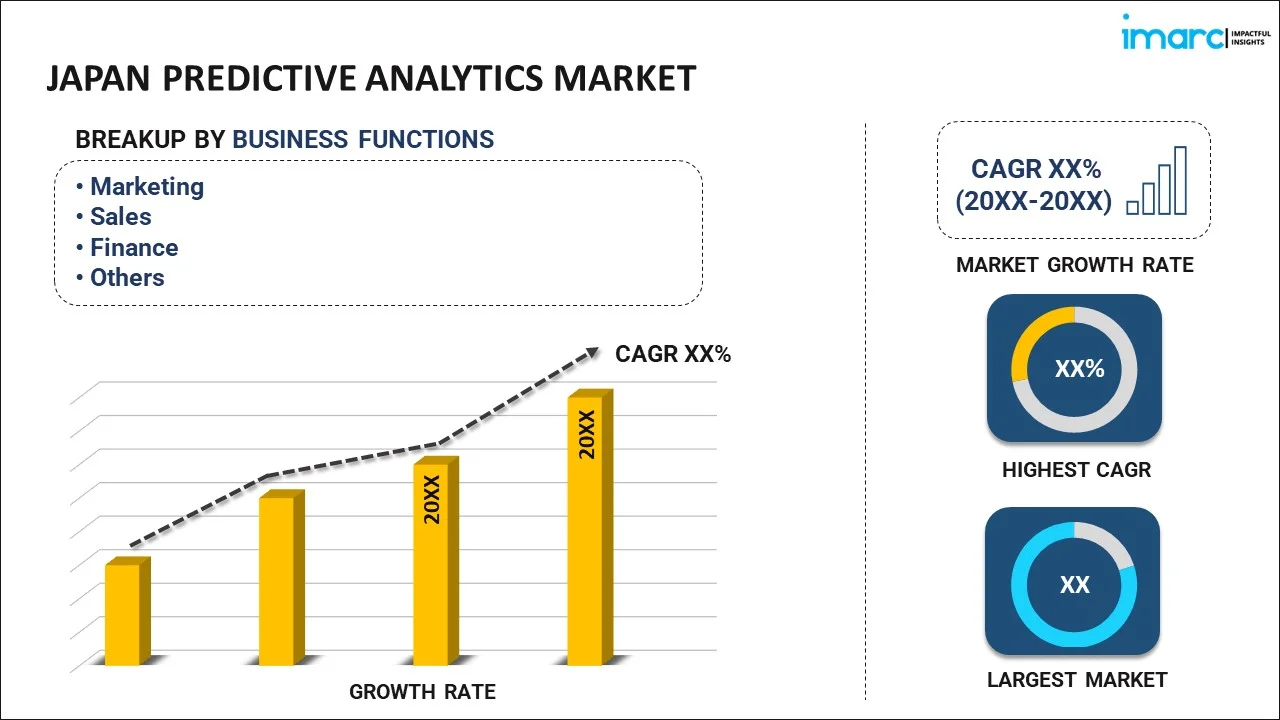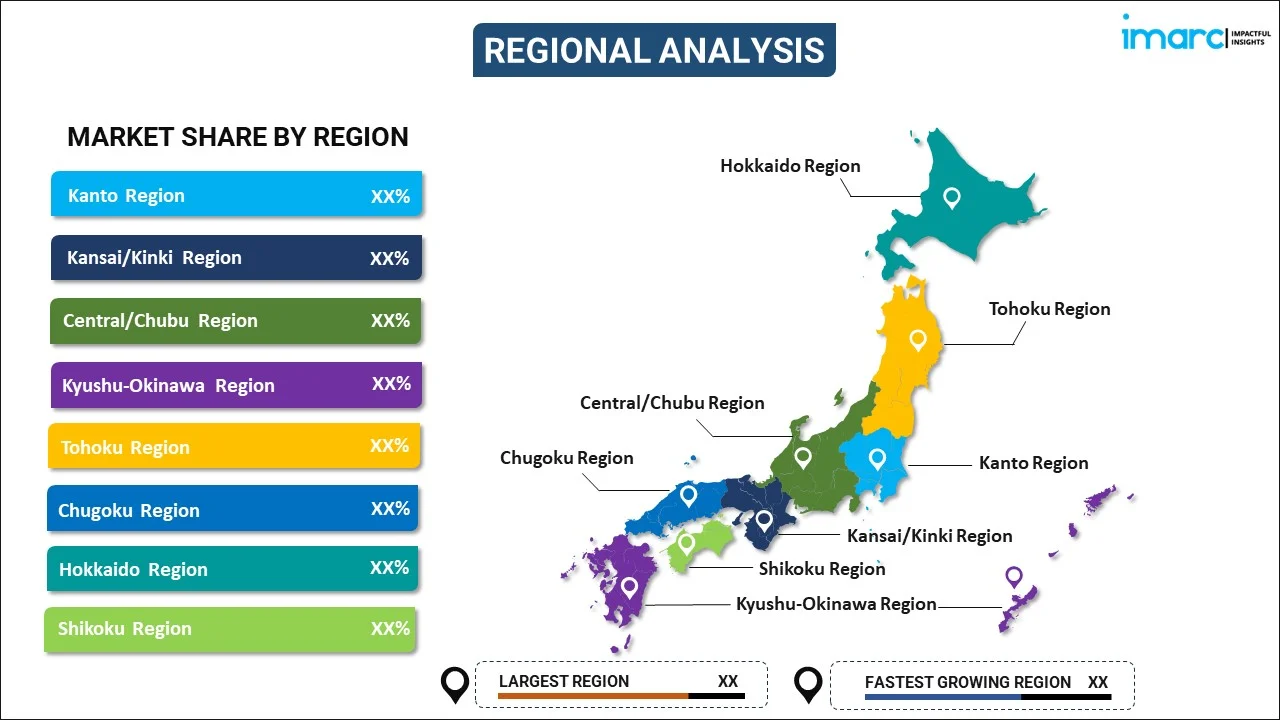
Japan Predictive Analytics Market Report by Business Function (Marketing, Sales, Finance, Human Resource, Operations, and Others), Component (Solution, Service), Deployment (Cloud-based, On-premises), Organization Size (Small and Medium-sized Enterprises, Large Enterprises), End Use Industry (Banking, Financial Services and Insurance, Telecommunication and IT, Retail and E-Commerce, Healthcare and Life Science, Manufacturing, Government and Defense, Energy and Utility, Transport and Logistics, Media and Entertainment, and Others), and Region 2026-2034
Market Overview:
Japan predictive analytics market size reached USD 1,062.5 Million in 2025. Looking forward, IMARC Group expects the market to reach USD 7,886.6 Million by 2034, exhibiting a growth rate (CAGR) of 24.95% during 2026-2034. The growing demand among online retailers for customer analytics solutions to perform real-time analysis of individual shopping behavior is primarily driving the market growth.
|
Report Attribute
|
Key Statistics
|
|---|---|
|
Base Year
|
2025 |
|
Forecast Years
|
2026-2034
|
|
Historical Years
|
2020-2025
|
| Market Size in 2025 | USD 1,062.5 Million |
| Market Forecast in 2034 | USD 7,886.6 Million |
| Market Growth Rate (2026-2034) | 24.95% |
Predictive analytics refers to an advanced analytics field focused on forecasting future events through the examination of historical and present data. It employs a range of statistical methods for data analysis, including data mining, machine learning, big data analytics, and artificial intelligence techniques. The primary benefits of predictive analytics encompass the mitigation of financial risks, fraud detection, optimization of marketing initiatives, improved operational efficiency, and the enhancement of overall customer experiences. Given its multifaceted advantages, predictive analytics has gained widespread adoption across a diverse array of sectors, including telecommunications, information technology, retail, healthcare, manufacturing, government, energy, transportation, and media and entertainment, among others.
Japan Predictive Analytics Market Trends:
In the Japan market, the adoption of predictive analytics is on the rise, driven by several key factors. Firstly, there is a growing trend towards automation in various industries. This trend has led to an increased need for predictive analytics to analyze large volumes of data and forecast future scenarios with significant revenue potential. Furthermore, intense competition in the business landscape is fueling the demand for predictive insights. Moreover, the expanding e-commerce sector in Japan is contributing to market growth. Online retailers are increasingly turning to customer analytics solutions, driving the adoption of predictive analytics. The growing penetration of e-commerce platforms has also led to increased demand for improved logistics and warehousing services that utilize real-time supply chain analytics. Additionally, the rising digitization in the Banking, Financial Services, and Insurance (BFSI) sector is driving the adoption of predictive analytics. This digitalization aims to enhance regulatory compliance processes, including credit risk management, capital planning, and insurance risk management. Furthermore, the increasing integration of advanced technologies like artificial intelligence (AI), data mining, augmented and virtual reality, big data, and machine learning is bolstering the adoption of predictive analytics. Looking ahead, the market is expected to be driven by the growing deployment of cloud-based predictive solutions. These solutions offer faster data processing and increased flexibility in business operations, which will likely fuel the adoption of predictive analytics in the coming years.
Japan Predictive Analytics Market Segmentation:
IMARC Group provides an analysis of the key trends in each segment of the market, along with forecasts at the country level for 2026-2034. Our report has categorized the market based on business function, component, deployment, organization size, and end use industry.
Business Function Insights:

- Marketing
- Sales
- Finance
- Human Resource
- Operations
- Others
The report has provided a detailed breakup and analysis of the market based on the business function. This includes marketing, sales, finance, human resource, operations, and others.
Component Insights:
- Solution
- Customer Analytics
- Financial Analytics
- Marketing and Sales Analytics
- Network Analytics
- Risk Analytics
- Supply Chain Analytics
- Web and Social Media Analytics
- Operations Management
- Workforce Management
- Others
- Service
- Deployment/Installation
- Training and Consulting
- Support and Maintenance
A detailed breakup and analysis of the market based on the component have also been provided in the report. This includes solution (customer analytics, financial analytics, marketing and sales analytics, network analytics, risk analytics, supply chain analytics, web and social media analytics, operations management, workforce management, and others), and service (deployment/installation, training and consulting, support and maintenance).
Deployment Insights:
- Cloud-based
- On-premises
A detailed breakup and analysis of the market based on the deployment have also been provided in the report. This includes cloud-based and on-premises.
Organization Size Insights:
- Small and Medium-sized Enterprises
- Large Enterprises
The report has provided a detailed breakup and analysis of the market based on organization size. This includes small and medium-sized enterprises and large enterprises.
End Use Industry Insights:
- Banking, Financial Services and Insurance
- Telecommunication and IT
- Retail and E-Commerce
- Healthcare and Life Science
- Manufacturing
- Government and Defense
- Energy and Utility
- Transport and Logistics
- Media and Entertainment
- Others
A detailed breakup and analysis of the market based on the end use industry have also been provided in the report. This includes banking, financial services and insurance, telecommunication and IT, retail and E-commerce, healthcare and life science, manufacturing, government and defense, energy and utility, transport and logistics, media and entertainment, and others.
Regional Insights:

- Kanto Region
- Kansai/Kinki Region
- Central/ Chubu Region
- Kyushu-Okinawa Region
- Tohoku Region
- Chugoku Region
- Hokkaido Region
- Shikoku Region
The report has also provided a comprehensive analysis of all the major regional markets, which include Kanto Region, Kansai/Kinki Region, Central/ Chubu Region, Kyushu-Okinawa Region, Tohoku Region, Chugoku Region, Hokkaido Region, and Shikoku Region.
Competitive Landscape:
The market research report has also provided a comprehensive analysis of the competitive landscape. Competitive analysis such as market structure, key player positioning, top winning strategies, competitive dashboard, and company evaluation quadrant has been covered in the report. Also, detailed profiles of all major companies have been provided.
Japan Predictive Analytics Market Report Coverage:
| Report Features | Details |
|---|---|
| Base Year of the Analysis | 2025 |
| Historical Period | 2020-2025 |
| Forecast Period | 2026-2034 |
| Units | Million USD |
| Scope of the Report | Exploration of Historical and Forecast Trends, Industry Catalysts and Challenges, Segment-Wise Historical and Predictive Market Assessment:
|
| Business Functions Covered | Marketing, Sales, Finance, Human Resource, Operations, Others |
| Components Covered |
|
| Deployments Covered | Cloud-based, On-premises |
| Organization Sizes Covered | Small and Medium-sized Enterprises, Large Enterprises |
| End Use Industries Covered | Banking, Financial Services and Insurance, Telecommunication and IT, Retail and E-Commerce, Healthcare and Life Science, Manufacturing, Government and Defense, Energy and Utility, Transport and Logistics, Media and Entertainment, Others |
| Regions Covered | Kanto Region, Kansai/Kinki Region, Central/ Chubu Region, Kyushu-Okinawa Region, Tohoku Region, Chugoku Region, Hokkaido Region, Shikoku Region |
| Customization Scope | 10% Free Customization |
| Post-Sale Analyst Support | 10-12 Weeks |
| Delivery Format | PDF and Excel through Email (We can also provide the editable version of the report in PPT/Word format on special request) |
Key Questions Answered in This Report:
- How has the Japan predictive analytics market performed so far and how will it perform in the coming years?
- What has been the impact of COVID-19 on the Japan predictive analytics market?
- What is the breakup of the Japan predictive analytics market on the basis of business function?
- What is the breakup of the Japan predictive analytics market on the basis of component?
- What is the breakup of the Japan predictive analytics market on the basis of deployment?
- What is the breakup of the Japan predictive analytics market on the basis of organization size?
- What is the breakup of the Japan predictive analytics market on the basis of end use industry?
- What are the various stages in the value chain of the Japan predictive analytics market?
- What are the key driving factors and challenges in the Japan predictive analytics?
- What is the structure of the Japan predictive analytics market and who are the key players?
- What is the degree of competition in the Japan predictive analytics market?
Key Benefits for Stakeholders:
- IMARC’s industry report offers a comprehensive quantitative analysis of various market segments, historical and current market trends, market forecasts, and dynamics of the Japan predictive analytics market from 2020-2034.
- The research report provides the latest information on the market drivers, challenges, and opportunities in the Japan predictive analytics market.
- Porter's five forces analysis assist stakeholders in assessing the impact of new entrants, competitive rivalry, supplier power, buyer power, and the threat of substitution. It helps stakeholders to analyze the level of competition within the Japan predictive analytics industry and its attractiveness.
- Competitive landscape allows stakeholders to understand their competitive environment and provides an insight into the current positions of key players in the market.
Need more help?
- Speak to our experienced analysts for insights on the current market scenarios.
- Include additional segments and countries to customize the report as per your requirement.
- Gain an unparalleled competitive advantage in your domain by understanding how to utilize the report and positively impacting your operations and revenue.
- For further assistance, please connect with our analysts.
 Request Customization
Request Customization
 Speak to an Analyst
Speak to an Analyst
 Request Brochure
Request Brochure
 Inquire Before Buying
Inquire Before Buying




.webp)




.webp)












